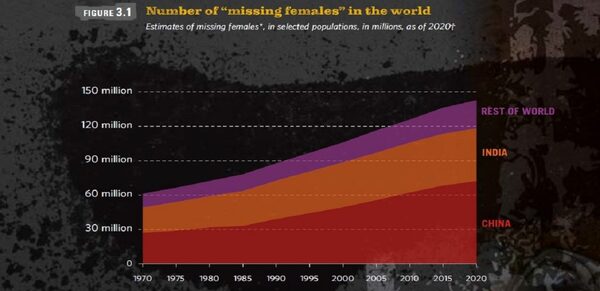India’s Missing Women Remain A Global Concern

Only 810 girl children are born per 1000 boys in urban Uttarakhand. In rural areas, the state recorded a comparably higher sex ratio at birth (female births per 1000 male births) of 851.
Overall, the Northern hill state of India showed the lowest sex ratio at birth at 840 females per 1000 males according to the latest data (2018) from the Sample Registration System (SRS), released by the Office of the Registrar General & Census Commissioner, in August 2019.
While rural parts of the state showed an improvement of two points, there was a slip of six points per 1000 in urban regions since the last survey in 2015-2017. The state which once had a sex ratio of 871 in 2012 had, over the years, seen fewer girl children at birth- an area of grave concern.
Uttarakhand is not alone.
Six large states – Delhi, Bihar, Karnataka, Odisha, Chhattisgarh and Maharashtra reported a decline in sex ratios at birth. Delhi, which is also the capital of India had the third worst sex ratio at birth.
Haryana, the state that had long been in the news for lowest female to male sex ratios in India showed an improvement from 833 to 843 recoded female births over 1000 male births in the last two SRS surveys conducted between 2015 and 2018. This implies that, between the last two surveys, one more girl was born for every 100 male children.
While 15 states of India showed an improvement in female births, the overall sex ratio has shown a small improvement from 896 to 899, between 2015-17 and 2016-18 rounds of surveys.
Source: SRS Bulletin
Along with a skewed sex ratio at birth, a drop in the number of women in India has also raised concerns in the global community.
460,000 girls were recorded as “missing” at birth between 2013-2017 in India according to the new State of the World Population Report, 2020 released by the United Nations Fund for Population (UNFPA), a UN agency that works in the field of population, sexual and reproductive health. Globally, 1.2 million females were missing at birth.
Globally, the number of missing women has doubled in the last 50 years. Today, 142.6 million girls and women across the globe are found missing. India reported 45.8 million missing women. In fact, China and India are reported to have an estimated 90% to 95% “missing women” among the countries of the world in the data presented by the UNFPA’s report.
Given this context, Behanbox explores the demographic trends and analyses data (and its limitations) that show gender-based inequalities and criminal violence against women in India.
Sex Ratio at Birth in India
India’s sex ratio at birth showed a worrying trend in SRS surveys conducted between 2012-14 and 2016-18.
In the five consecutive surveys between those years, conducted after the 2011 census, the overall child sex ratio at birth in India dropped from 906 to 896.
It was only in 2018, the overall sex ratio at birth saw a an improvement – by three points per 1000.
Source: SRS Bulletin
Sex Ratio at Birth is expressed as the number of girls born alive per 1000 boys. In India, the Office of the Registrar General & Census Commissioner estimates the birth and death statistics. The procedure to conduct surveys works under the Sample Registration System (SRS) field investigations.
India is only second to China in reporting the worst statistics of sex ratios among countries. The findings from the UNFPA’s State of the World Population, 2020 report released on 30th of June 2020 shows that these two countries account for around ninety percent to ninety-five percent of the estimated 1.2 million to 1.5 million missing female births annually in the world.
Skewed sex ratios at birth, says the UNFPA report, emerged in the 1980s in China, India and the Republic of Korea and in the 1990s in Eastern European countries. In countries like Nepal and Vietnam, the phenomenon emerged after 2000.
While many countries like Republic of Korea, Vietnam and Singapore, have seen a shift in ratios to nearly natural levels, the improvements in India are variegated with declines in some states offsetting some of the gains made by others.
Source: UNFPA State of the World Population Report, 2020
The sociological reasons for “missing women” in the Indian society are a multi-variable web of social conditioning, patriarchal norms and economic costs and benefits.
Son preference is one of the major reasons attributed to missing women. Attitudinal studies on son preference in India link it to strong patrilineal family structures and expectations of parents to live with sons in old age. As a result, girls suffer educational, health and nutritional discrimination.
Patriarchal attitudes and cultural practices that lead to exclusion, violence and exploitation of women in the world—with societal variations– are also reasons for the glaring statistics on missing women.
The UNFPA report also comparatively analyses various aspects of missing women in our societies, using specific studies on sex-selective abortions, child marriages, dowry and bride prices and other form of physical, psychological and intimate violence against women from India, China and other parts of the world.
India’s ‘Excess Death Rate’ of Under Five Girls Highest in the World
The number of missing girls at birth and excess female deaths in the world’s population has more than doubled in the last fifty years– from 61.0 million in 1970 to 142.6 million in 2020- according to the demographic estimates by the latest UNFPA report.
India also has the highest rate of excess female deaths in under the age of five years.
Excess female death rates is a demographic estimation that calculates the number of excess deaths above the normal or expected death rates in the age group per 1000 population.
India recorded more than thirteen excess deaths for every 1000 girls under five years of age.
More than ninety percent of districts had excess female mortality. The four largest states in northern India–Uttar Pradesh, Bihar, Rajasthan, and Madhya Pradesh– accounted for two-thirds of India’s total number according to a study by Christophe Z Guilmoto and others.
Comparably, Afghanistan lost more than five and Pakistan more than four girls in excess- one of the most notable findings of the report.
While researchers agree that there is a lack of reliable data from the field, a 2014 study by Leontine Alkema and others used a variety of sources to develop methods to measure ‘excess female mortality’.
This study estimated that one in nine deaths of females below the age of five may be attributed to postnatal sex selection in India. The same research also indicates that the number of females who were missing because of gender-biased sex selection was larger than those who were missing because of postnatal sex selection.
Source: UNFPA State of the World Population Report, 2020
The Entry of Sex-selective Abortions Market in India
Amartya Sen, in his 1992 article in the British Medical Journal, was the first to bring to attention the phenomenon of India’s “missing women”. The article was a commentary on women’s survival advantage in Asia and Africa. The reasons for high rates of female deaths in India were noted as maternal mortality (in child bearing age), infanticide (based on reported incidents) and neglect of health and nutrition of girls and women. Sex-selective abortions were not mentioned in this analysis.
The technology for sex-selective abortions became available in the 1970s in the advanced countries. In India, however, sex-selective abortions became widespread with the entry of diagnostics like ultrasound technology between 1980-90s .
In 1994 the Pre-natal diagnostic Techniques (Regulation and Prevention of the Misuse) Act (PC & PNDT Act) was passed- that prohibited abortions based on sex determination of the foetus and made it a criminal offense. Despite this, private clinics continue to flout the law by offering sex-determination tests, especially in cities.
In the SRS data for 2018, ten states– among which, notably, Delhi, Chhattisgarh, Karnataka, Odisha, Telangana and Uttarakhand, reported lower sex ratios at birth in urban areas.
While, the data at the all India level shows that there are three fewer girls being born in urban areas than rural, state wise trends vary a lot.
Delhi has the highest urban-rural gap for sex ratios at birth. 119 per 1000 more girls were born in rural Delhi over urban areas; followed by Chhattisgarh (95), Karnataka (68), Odisha (49), Telangana (43) and Uttarakhand (41).
However, the thirteen other states from the SRS survey show an opposite trend. UP’s urban areas, for example, had sixty-nine per 1000 more girls born over rural districts; followed by MP at fifty-four and Punjab at thirty per 1000 points.
Criminal Reporting of Female Deaths: Challenges in Data Collection
Finding reliable evidence– both for criminal investigation and sociological research– on pre-natal sex selection and foeticide however, is still a challenge. The National Crime Records Bureau (NCRB) reports miscarriage, infanticide, foeticide and abandonment as crimes under the IPC (Indian Penal Code). These reported incidences could constitute a reliable evidence of sex-selective deaths. However, with low levels of reporting and loopholes in the justice system, reliability of the NCRB data is questionable.
Source: National Crime Records Bureau
The crime records bureau shows 1728 incidences of foeticide and infanticide from 2018. This data is recorded as crimes against children and does not specify the gender of the victims in the report.
Another aspect of excess deaths of women is violent crimes against women. In India, dowry deaths are another major category of deaths of women. According to the NCRB report– 7166 incidents were reported in 2018. 294 incidences of murder with rape were reported in the same year. But it is difficult to account this into the statistics of missing women because in most cases, ‘murder with rape’ is only recorded as murder when the First Information Report (FIR) is lodged.
Notes:
(NCRB definition of Crime against women: Majority of cases under crimes against women out of total IPC crimes against women were registered under ‘Cruelty by Husband or His Relatives’ (31.9%) followed by ‘Assault on Women with Intent to Outrage her Modesty’ (27.6%), ‘Kidnapping & Abduction of Women’ (22.5%) and ‘Rape’ (10.3%). The crime rate per lakh women population is 58.8 in 2018 in comparison with 57.9 in 2017. )
UNFPA report has sex ratios expressed in males per 1000 females and Indian census expresses it as females per 1000 males- the story uses the figures as reported from the particular source.
Saumya Tewari holds a PhD in Development Studies from TISS, Mumbai and is an Honorary Associate Fellow at the Centre for Multilevel Federalism, New Delhi.
All Visualisations in the story by Pragnya Reddy
We believe everyone deserves equal access to accurate news. Support from our readers enables us to keep our journalism open and free for everyone, all over the world.







